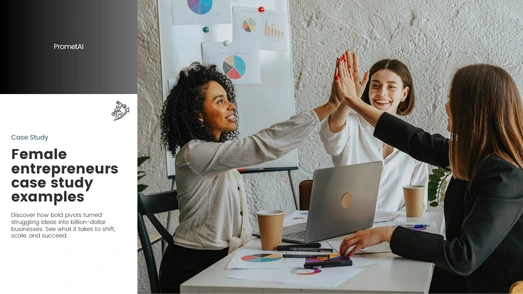Explore inspiring case studies of famous female entrepreneurs—how Sara Blakely, Oprah Winfrey, Whitney Wolfe Herd built billion-dollar empires from scratch.
Case Study 1: How Sara Blakely Built SPANX into a $1.2 Billion Empire with Zero Experience
In 2000, Sara Blakely launched SPANX with nothing more than $5,000 in savings and a relentless belief that women deserved something better. What began as a side project from an apartment in Atlanta became a global shapewear entrepreneur success story, proving that a female founder success story can redefine an entire industry. With no outside investors, Blakely grew a self-funded business into a women’s fashion startup that captured the imagination of millions.
Today, SPANX stands as one of the most iconic female entrepreneur examples, achieving a $1.2 billion valuation after its acquisition by Blackstone in 2021.
About the business
Name: Sara Blakely / SPANX
Location: Atlanta, Georgia, USA
Type: Shapewear and women’s undergarments company
Founded: 2000
Valuation: $1.2 billion (2021 Blackstone acquisition)
Sara Blakely’s story highlights the brutal realities of female entrepreneur challenges. She had no social capital in the fashion industry, no connections to manufacturers, no track record in retail, and no credibility in the eyes of factories that rejected her early prototypes.
The product development challenges were immediate. She needed to create shapewear that could prove its effect not over weeks of wear, but in a matter of minutes. The problem was clear: unless customers could see and feel the transformation instantly, it would be dismissed as another gimmick.
On top of that, Blakely faced startup funding challenges that many women entrepreneur obstacles make familiar: no outside investors, no marketing budget, and no safety net. Breaking into premium retail without relationships seemed impossible. Add to this the retail industry competition from established brands, and her odds looked slim. Yet these barriers became the crucible that shaped her unconventional path.
Blakely’s approach was defined by creativity and scrappiness, qualities that became her competitive edge.
Product-first innovation. She focused on building a product that could sell itself through instant transformation. By partnering with contract factories and perfecting prototypes, she created shapewear that could demonstrate its effect in under a minute, a true product demonstration strategy designed for quick persuasion.
Branding with personality. Instead of clinical or intimidating branding, Blakely infused SPANX with humor, color, and relatability. The bold name (with its sharp “k” ending) stood out in a crowded aisle, while packaging featured “real women” to convey female entrepreneur marketing authenticity. This playful tone built instant emotional connections with buyers.
Retail entry by proof, not pitch decks. With no marketing budget, Blakely personally convinced a Neiman Marcus buyer by trying the product in the bathroom during their meeting. That bold demo unlocked the premium retail strategy, quickly followed by Saks, Bloomingdale’s, and Bergdorf Goodman.
Earned media over paid advertising. With zero funds for billboards or commercials, Blakely relied on earned media marketing. The breakthrough came when SPANX landed on Oprah’s “Favorite Things” list. The endorsement catapulted sales and became the ultimate example of influencer partnerships before influencer marketing was mainstream.
Bootstrap discipline. Refusing outside investment for two decades, Blakely followed a bootstrap funding strategy that allowed her to keep control. When she finally brought in Blackstone, she did so from a position of strength, forming an all-female board in one of the most celebrated exits in product-market fit history.
The Results (After 21 Years)
What began with a pair of scissors and $5,000 turned into one of the most remarkable female entrepreneur success metrics stories in retail.
By 2021, SPANX was no longer a novelty brand but the undisputed shapewear market leader. From a single prototype, Blakely expanded into over 10,000 retail expansion success locations worldwide, establishing a presence in every major department store.
The company’s billion-dollar valuation validated her choices in branding, self-funding, and growth strategy. SPANX became synonymous with shapewear, turning the founder into a self-made billionaire and securing her place among iconic women-led business growth stories.
Performance snapshot
Metric | Before (2000) | After (2021) | Change |
Market Position | Unknown startup | Market leader | Category creator |
Retail Locations | 0 | 10,000+ | Nationwide presence |
Company Valuation | $5,000 investment | $1.2 billion | 240,000x ROI |
Brand Recognition | None | Synonymous with shapewear | Category defining |

The SPANX journey underscores powerful lessons for entrepreneurs everywhere:
Demo magic matters. Design products that deliver visible change in seconds; a quick demo can outperform any pitch deck.
Earned influence beats big budgets. One placement in the right hands, Oprah, in Blakely’s case, can achieve what millions in advertising cannot.
Bootstrap until dominance. Retaining control until achieving category leadership gives founders maximum leverage with investors.
Authenticity commands a premium. By celebrating real women, Blakely turned brand authenticity importance into premium positioning and customer loyalty.
Pitfalls remain instructive, too. Moving too quickly into unrelated categories risks diluting focus, and scaling retail without adequate social proof can backfire.
Ultimately, SPANX is more than a female entrepreneur lessons learned story; it is a blueprint for how vision, persistence, and authenticity can rewrite the rules of an industry.
